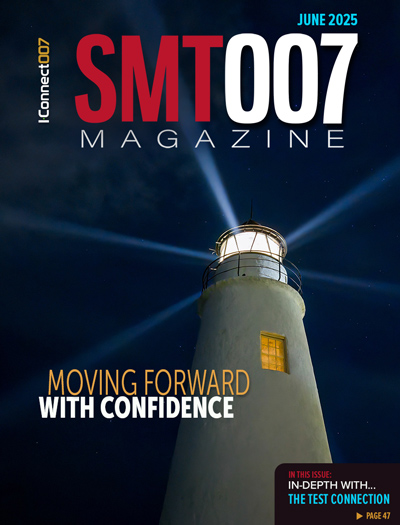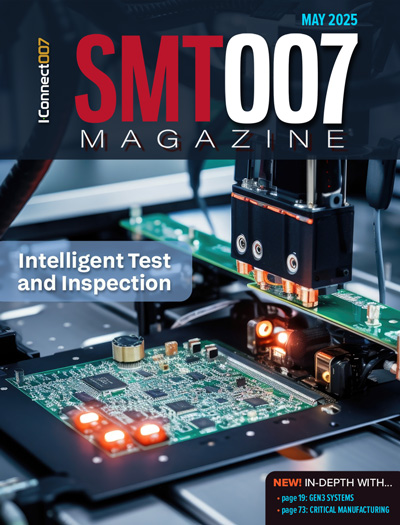-

- News
- Books
Featured Books
- smt007 Magazine
Latest Issues
Current Issue
What's Your Sweet Spot?
Are you in a niche that’s growing or shrinking? Is it time to reassess and refocus? We spotlight companies thriving by redefining or reinforcing their niche. What are their insights?

Moving Forward With Confidence
In this issue, we focus on sales and quoting, workforce training, new IPC leadership in the U.S. and Canada, the effects of tariffs, CFX standards, and much more—all designed to provide perspective as you move through the cloud bank of today's shifting economic market.

Intelligent Test and Inspection
Are you ready to explore the cutting-edge advancements shaping the electronics manufacturing industry? The May 2025 issue of SMT007 Magazine is packed with insights, innovations, and expert perspectives that you won’t want to miss.
- Articles
- Columns
- Links
- Media kit
||| MENU - smt007 Magazine
IPC Standards Committee Reports – Packaged Electronic Components, Flex Circuits, High Speed/High Frequency, Rigid Printed Boards
December 7, 2015 | IPCEstimated reading time: 4 minutes
The reactivated D-22 High Speed/High Frequency Design Subcommittee met to review an initial draft of IPC-2228, Sectional Design Standard for High Frequency (RF/Microwave) Printed Boards. While agreed that the document is not intended to be used as a stand-alone document (it will support the IPC-2221B, Generic Standard on Printed Board Design), the initial draft does contain a substantial amount of “how-to 101” tutorial information for the designer as taken from the older IPC-2252, Design Guide for RF/Microwave Printed Boards. It was decided that IPC should conduct an open-ended industry survey that asks two basic questions to help steer the course of the IPC-2228:
- If a printed board fabricator switched up a job from an FR-4 board (IPC-6012) to an RF board (IPC-6018), what things would the fabricator need to focus on for that job (e.g. drilling, plating and marking)?
- What elements of fabrication and assembly are different between traditional rigid printed boards and RF printed boards that IPC should focus on (e.g. sequential lamination, back drilling and material handling)?
The D-22 High Speed/High Frequency Performance Subcommittee met to complete the process of reviewing and providing disposition to industry comments submitted during the summer 2015 Final Draft circulation of IPC-6018C, Qualification and Performance Specification for High Frequency (Microwave) Printed Boards. The document will now be prepared for official balloting and a corresponding IPC-6018CS Space and Military Avionics Applications Addendum will also be drafted for a 2016 release.
The D-24a TDR Test Methods Task Group met to review the status of the Gage R&R Validation Program for the forthcoming “B” Revision to IPC-TM-650, Method 2.5.5.7, Characteristic Impedance of Lines on Printed Boards by TDR.
The D-24b Bereskin Test Methods Task Group met to review two different industry approaches to addressing the Bereskin stripline resonator test method that lends itself to the test and measurement of Dk and Df of thin dielectric materials up to 20 GHz. An IPC-TM-650 Test Method could be developed that provides both procedures as Methods A and B.
The D-24c High Frequency Test Methods Task Group meet to review data from five participating companies in a round robin test program that will assess the state-of-the-art of test material provides and testing labs in the measurement of dielectric properties of materials at frequencies above 10 GHz. A variety of test methods are being utilized based on current practices utilized in commerce.
Page 2 of 3
Suggested Items
DownStream Acquisition Fits Siemens’ ‘Left-Shift’ Model
06/26/2025 | Andy Shaughnessy, I-Connect007I recently spoke to DownStream Technologies founder Joe Clark about the company’s acquisition by Siemens. We were later joined by A.J. Incorvaia, Siemens’ senior VP of electronic board systems. Joe discussed how he, Rick Almeida, and Ken Tepper launched the company in the months after 9/11 and how the acquisition came about. A.J. provides some background on the acquisition and explains why the companies’ tools are complementary.
Elementary Mr. Watson: Retro Routers vs. Modern Boards—The Silent Struggle on Your Screen
06/26/2025 | John Watson -- Column: Elementary, Mr. WatsonThere's a story about a young woman preparing a holiday ham. Before putting it in the pan, she cuts off the ends. When asked why, she shrugs and says, "That's how my mom always did it." She asks her mother, who gives the same answer. Eventually, the question reaches Grandma, who laughs and says, "Oh, I only cut the ends off because my pan was too small." This story is a powerful analogy for how many PCB designers approach routing today.
Connect the Dots: The Future of PCB Design and Manufacturing
07/02/2025 | Matt Stevenson -- Column: Connect the DotsFor some time, I have been discussing the increasing complexity of PCBs and how designers can address the constantly evolving design requirements associated with them. My book, "The Printed Circuit Designer’s Guide to… Designing for Reality," details best practices for creating manufacturable boards in a modern production environment.
Siemens Turbocharges Semiconductor and PCB Design Portfolio with Generative and Agentic AI
06/24/2025 | SiemensAt the 2025 Design Automation Conference, Siemens Digital Industries Software today unveiled its AI-enhanced toolset for the EDA design flow.
Cadence AI Autorouter May Transform the Landscape
06/19/2025 | Andy Shaughnessy, Design007 MagazinePatrick Davis, product management director with Cadence Design Systems, discusses advancements in autorouting technology, including AI. He emphasizes a holistic approach that enhances placement and power distribution before routing. He points out that younger engineers seem more likely to embrace autorouting, while the veteran designers are still wary of giving up too much control. Will AI help autorouters finally gain industry-wide acceptance?


